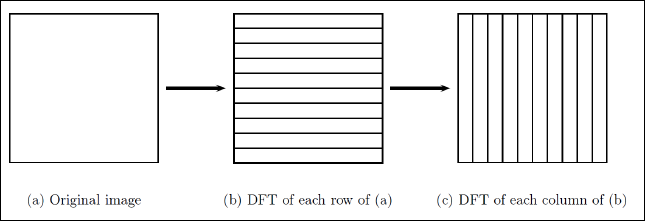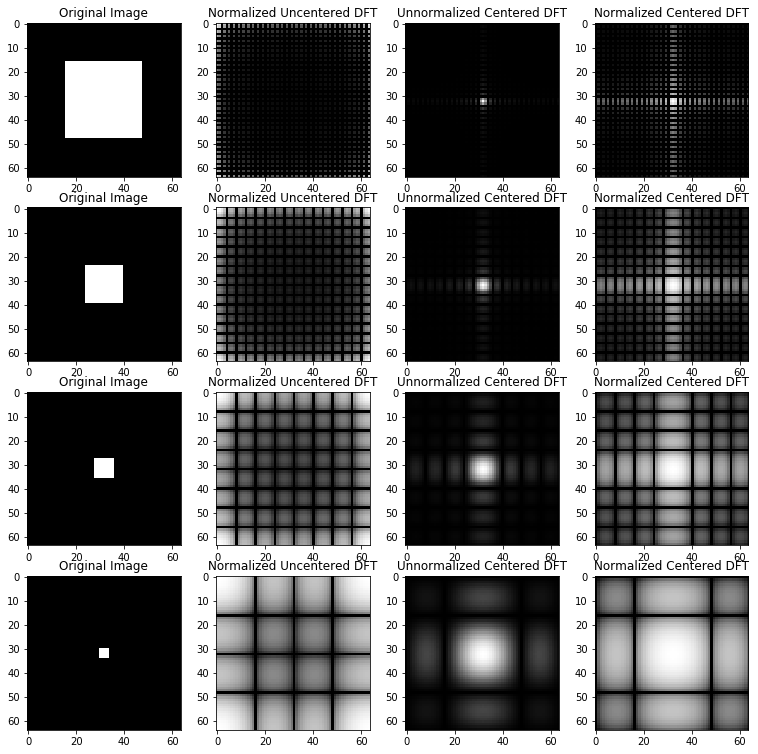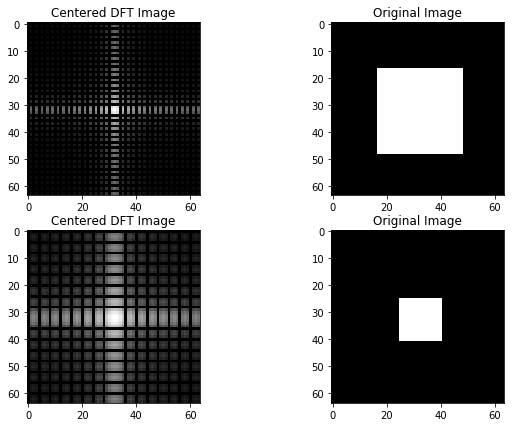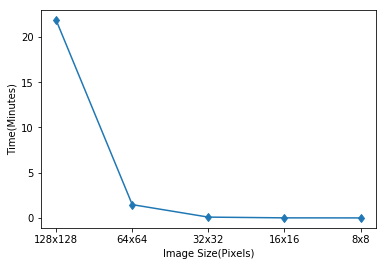Implementing Discrete Fourier Transform Using Python
Table of Contents
Introduction
Digital images are usually stored and displayed in space domain. That is, each point/pixel in the image contains an integer value that shows the color intensity value. For example, if we have 8x8 image, then there are 64 values that are stored in each pixel location.
However, images can be transformed in to their corresponding frequecy domain representation. The advantage of the transformation is that several image processing tasks are well done in their transformed format. For example, they can be used for:
- Image Enhancement
- Image Restoration
- Image Coding
- Image Compression
Then, after these processes are performed, the processed image can be returned back to its original space domain form by using inverse transform process. There are several types of transforms, such as:
- Discrete Fourier Transform (DFT)
- Discrete Cosine Transform (DCT)
- Walsh-Hadamard Transform
- Haar Transform
In this post, we are only concerned with DFT.
A 2-dimensional DFT (2D-DFT) decomposes an image into its sinusoidal components (sines and cosines). As explained above, the input is the image in its spatial domain. In contrast, the output will be the image’s representation in its fourier or frequency domain. DFT is a complex number transform as it has both the real (cosine) and imaginary (sine) components as an output.
Let the size of an input image be NxN. The general form is:
The above formula is forward DFT transformation.
Similarly, for inverse DFT transformation:
- $ k(x,y,u,v)=e^{(-j2\pi\frac{ux+vy}{N})} $ is called basis function (kernel function)
To find the real and imaginary part of the transformed image:
Since the kernel function in DFT is separable:
So, the 2D-DFT formula can be computed as a sequence of two 1D-DFT transform. That is, each row of the original image is transformed and then each column of the previous result is transformed. This can be visualized as follows and was taken from here:

Similarly, we can also apply the same technique to compute the inverse transformation:
For the forward transformation:
And for the inverse transformation:
Where:
-
$ k_f $ = kernel function of the forward transformation
-
$ k_i $= kernel function of the inverse transformation*
-
$ k_i = k_f^{-1} $ and $ k_i = k_f^T $ (Since the kernel function is orthogonal).
-
And $ k_f = k_f^{T}$ (Since it is a symmetric function)
-
So, $ k_i = k_f^{*T}$
Therefore:
In the next section, the forward DFT will be implemented in python. Finally they will be tested with images of different sizes. And their running time will be computed and visualized.
Python Implementation
First of all, let’s import the necessary python libraries
import numpy as np
import matplotlib.pyplot as plt
%matplotlib inline
#import matplotlib.image as img
import PIL.Image as Image
import math
import cmath
import time
import csv
Now let’s start with creating common image functions.
def generateBlackAndWhiteSquareImage(imgSize):
"""
Generates a square-sized black and white image with a given input size.
Parameters
----------
imgSize : int
Input number that stores the dimension of the square image to be generated.
Returns
-------
imge : ndarray
The generated black and white square image.
"""
#Creating a matrix with a given size where all the stored values are only zeros (for initialization)
imge = np.zeros([imgSize, imgSize], dtype=int)
#Starting and ending indices of the white part of the image.
ind1 = imgSize/4
ind2 = ind1 + (imgSize/2)
#Make a part of the image as white (255)
imge[ind1:ind2, ind1:ind2] = np.ones([imgSize/2, imgSize/2], dtype=int)*255
#return the resulting image
return imge
def generateImagesWithResizedWhite(imge):
"""
Generates images with the same size as the original but with a resized white part of them.
"""
N = imge.shape[0]
imges = []
i = N/2
while i >= 4:
j = (N - i)/2
#Starting and ending indices for the white part.
indx1 = j
indx2 = j+i
#Draw the image.
imgeNew = np.zeros([N, N],dtype=int)
imgeNew[indx1:indx2, indx1:indx2] = np.ones([i, i], dtype=int)*255
#Add the image to the list.
imges.append(imgeNew)
i = i/2
return imges
def resizeImage(imge, newSize):
"""
Reduces the size of the given image.
Parameters
----------
imge : ndarray
Input array that stores the image to be resized.
Returns
-------
newSize : int
The size of the newly generated image.
"""
#Compute the size of the original image (in this case, only # of rows as it is square)
N = imge.shape[0]
#The ratio of the original image as compared to the new one.
stepSize = N/newSize
#Creating a new matrix (image) with a black color (values of zero)
newImge = np.zeros([N/stepSize, N/stepSize])
#Average the adjacent four pixel values to compute the new intensity value for the new image.
for i in xrange(0, N, stepSize):
for j in xrange(0, N, stepSize):
newImge[i/stepSize, j/stepSize] = np.mean(imge[i:i+stepSize, j:j+stepSize])
#Return the new image
return newImge
As a next step, the main class that implements a 2D DFT. Both the forward and inverse DFT will be implemented here.
Note: All the input images are assumed to be square in size. But the implementation can easily be modified to work with rectangular images (not squares).
class DFT(object):
"""
This class DFT implements all the procedures for transforming a given 2D digital image
into its corresponding frequency-domain image (Forward DFT Transform)
"""
@classmethod
def __computeConjugate(self, mat):
"""
Computes the conjugate of a complex square-matrix.
Parameters
----------
mat : ndarray
Input matrix of complex numbers.
Returns
-------
result : ndarray
The conjugate of the input matrix.
"""
N = mat.shape[0]
result = np.zeros([N, N], dtype=np.complex)
for i in range(N):
for j in range(N):
result[i, j] = (mat[i, j].real) - (mat[i, j].imag*1j)
return result
@classmethod
def __multiplyMatrices(self, mat1, mat2):
"""
Computes the multiplication of two complex square matrices.
Parameters
----------
mat1 : ndarray
First input matrix of complex numbers.
mat2 : ndarray
Second input matrix of complex numbers.
Returns
-------
result : ndarray
The multiplication result of the two matrices.
"""
N = mat1.shape[0]
result = np.zeros([N, N], np.complex)
#For each column and row...
for i in range(N):
row = mat1[i, :]
for j in range(N):
col = mat2[j, :]
total = 0 + 0j
for k in range(N):
total += row[k]*col[k]
result[i, j] = total
return result
#Compute the two separable kernels for the forward DFT.
@classmethod
def computeXForwardKernel(self, size):
"""
Computes/generates the first forward kernel function.
Parameters
----------
size : int
Size of the kernel to be generated.
Returns
-------
xKernel : ndarray
The generated kernel as a matrix.
"""
#Initialize the kernel
xKernel = np.zeros([size, size], dtype=np.complex)
#Compute each value of the kernel...
for u in range(size):
for x in range(size):
#Rounding it is used here for making the values integers as it will insert very small fractions.
xKernel[u, x] = math.cos((2*math.pi*u*x)/size) - (1j*math.sin((2*math.pi*u*x)/size))
#Return the resulting kernel
return xKernel
@classmethod
def computeYForwardKernel(self, xKernel):
"""
Computes/generates the second forward kernel function.
Parameters
----------
xKernel : ndarray
The first forward kernel function.
Returns
-------
yKernel : ndarray
The generated kernel as a matrix.
"""
#yKernel = np.conj(xKernel) ## In numpy package.
N = xKernel.shape[0]
#For each value, find the conjugate...
yKernel = np.zeros([N, N], dtype=np.complex)
for i in range(N):
for j in range(N):
yKernel[i, j] = (xKernel[i, j].real) - (xKernel[i, j].imag*1j)
# Return the resulting kernel (Since the original kernel is symmetric, transpose is not needed)
return yKernel
@classmethod
def computeCenteredImage(self, imge):
"""
Centers a given image.
Parameters
----------
imge : ndarray
Input array that stores the image to be centered.
Returns
-------
newImge : int
The new and centered version of the input image.
"""
#Compute the dimensions of the image
M, N = imge.shape
#centeringMatrix = np.zeros([M, N], dtype=int)
newImge = np.zeros([M, N], dtype=int)
for x in range(M):
for y in range(N):
newImge[x, y] = imge[x, y] * ((-1)**(x+y))
#newImge = imge * centeringMatrix
return newImge
@classmethod
def computeForward2DDFTWithSeparability(self, imge):
"""
Computes/generates the 2D DFT by computing the two forward kernels first (Separability).
Parameters
----------
imge : ndarray
The input image to be transformed.
Returns
-------
final2DDFT : ndarray
The transformed image.
"""
N = imge.shape[0]
xKernel = DFT.computeXForwardKernel(N)
yKernel = DFT.computeYForwardKernel(xKernel)
#row1DDFT = (1.0/size) * np.dot(xKernel, imge)
intermediate2DDFT = (1.0/N) * DFT.__multiplyMatrices(xKernel, imge)
final2DDFT = (1.0/N) * DFT.__multiplyMatrices(intermediate2DDFT, yKernel)
return final2DDFT
@classmethod
def __computeSinglePoint2DFT(self, imge, u, v, N):
"""
A private method that computes a single value of the 2DDFT from a given image.
Parameters
----------
imge : ndarray
The input image.
u : ndarray
The index in x-dimension.
v : ndarray
The index in y-dimension.
N : int
Size of the image.
Returns
-------
result : complex number
The computed single value of the DFT.
"""
result = 0 + 0j
for x in xrange(N):
for y in xrange(N):
result += (imge[x, y] * (math.cos((2*math.pi*(u*x + v*y))/N) -
(1j*math.sin((2*math.pi*(u*x + v*y))/N))))
return result
@classmethod
def computeForward2DDFTNoSeparability(self, imge):
"""
Computes/generates the 2D DFT by computing without separating the kernels.
Parameters
----------
imge : ndarray
The input image to be transformed.
Returns
-------
final2DDFT : ndarray
The transformed image.
"""
# Assuming a square image
N = imge.shape[0]
final2DDFT = np.zeros([N, N], dtype=np.complex)
for u in xrange(N):
for v in xrange(N):
#Compute the DFT value for each cells/points in the resulting transformed image.
final2DDFT[u, v] = DFT.__computeSinglePoint2DFT(imge, u, v, N)
return ((1.0/(N**2))*final2DDFT)
@classmethod
def computeInverse2DDFTWithSeparability(self, dftImge):
"""
Computes the inverse 2D DFT by computing the two inverse kernels first (Separability).
Parameters
----------
dftImge : ndarray
The dft transformed image as input.
Returns
-------
imge : ndarray
The resulting image in spatial domain from the inverse DFT.
"""
N = dftImge.shape[0]
#Here the kernels are interchanged from the forward DFT
yKernel = DFT.computeXForwardKernel(N)
xKernel = DFT.computeYForwardKernel(yKernel)
intermediateImge = DFT.__multiplyMatrices(xKernel, dftImge)
imge = DFT.__multiplyMatrices(intermediateImge, yKernel)
#imge = np.real(imge)
return imge
@classmethod
def compute2DDFTFourierSpectrum(self, dftImge):
"""
Computes the fourier spectrum of the transformed image.
Parameters
----------
dftImge : ndarray
The input transformed image.
Returns
-------
fourierSpect : ndarray
The computed fourier spectrum.
"""
N = dftImge.shape[0]
fourierSpect = np.zeros([N, N], dtype=float)
#Calculate the magnitude of each point(complex number) in the DFT image
for i in xrange(N):
for j in xrange(N):
v = dftImge[i, j]
fourierSpect[i, j] = math.sqrt((v.real)**2 + (v.imag)**2)
return fourierSpect
@classmethod
def normalize2DDFTByLog(self, dftImge):
"""
Computes the log transformation of the transformed DFT image to make the range
of the fourier values b/n 0 to 255
Parameters
----------
dftImge : ndarray
The input transformed image.
Returns
-------
dftNormImge : ndarray
The normalized version of the transformed image.
"""
#Compute the fourier spectrum of the transformed image:
dftFourierSpect = DFT.compute2DDFTFourierSpectrum(dftImge)
#Normalize the fourier spectrum values:
dftNormFourierSpect = (255.0/ math.log10(255)) * np.log10(1 + (255.0/(np.max(dftFourierSpect))*dftFourierSpect))
return dftNormFourierSpect
Testing the Code and Visualizing the DFT Running Time
Testing the DFT algorithm
For testing purposes, the 4x4 separable DFT kernels are computed:
# The numbers are rounded for visualization
xKernel = np.round(DFT.computeXForwardKernel(4))
print "The first 4x4 forward kernel:"
xKernel
The first 4x4 forward kernel:
array([[ 1.+0.j, 1.+0.j, 1.+0.j, 1.+0.j],
[ 1.+0.j, 0.-1.j, -1.-0.j, -0.+1.j],
[ 1.+0.j, -1.-0.j, 1.+0.j, -1.-0.j],
[ 1.+0.j, -0.+1.j, -1.-0.j, 0.-1.j]])
# The second kernel is the conjugate of the first (as the kernels are symmetric, we don't need to transpose)
yKernel = np.round(DFT.computeYForwardKernel(xKernel))
print "The first 4x4 forward kernel:"
yKernel
The first 4x4 forward kernel:
array([[ 1.+0.j, 1.+0.j, 1.+0.j, 1.+0.j],
[ 1.+0.j, 0.+1.j, -1.+0.j, -0.-1.j],
[ 1.+0.j, -1.+0.j, 1.+0.j, -1.+0.j],
[ 1.+0.j, -0.-1.j, -1.+0.j, 0.+1.j]])
Here, we generate an 8-bit gray scale image as a 64x64 matrix
imge = generateBlackAndWhiteSquareImage(64)
Generate images of the same size as above but with different white part size:
imges = generateImagesWithResizedWhite(imge)
To test the DFT with different images having different white size:
Here, we will generate the images, compute the DFT and visualize the results:
#For visualization:
N = len(imges)
fig, axarr = plt.subplots(N, 4, figsize=(13, 13))
#Compute DFT for each generated image...
dftImges = []
for i, imge in enumerate(imges):
#Center the generated image
centeredImge = DFT.computeCenteredImage(imge)
#Compute the 2D DFT transformation for both centered and uncentered images:
dftUncenteredImge = DFT.computeForward2DDFTWithSeparability(imge)
dftCenteredImge = DFT.computeForward2DDFTWithSeparability(centeredImge)
#Save the centered DFT images...
dftImges.append(dftCenteredImge)
#Normalize the computed DFT results:
dftUncenteredNormImge = DFT.normalize2DDFTByLog(dftUncenteredImge)
dftCenteredNormImge = DFT.normalize2DDFTByLog(dftCenteredImge)
#Display the normalized versions of the centered and uncentered images
axarr[i][0].imshow(imge, cmap=plt.get_cmap('gray'), vmin=0, vmax=255)
axarr[i][0].set_title('Original Image')
axarr[i][1].imshow(dftUncenteredNormImge, cmap=plt.get_cmap('gray'), vmin=0, vmax=255)
axarr[i][1].set_title('Normalized Uncentered DFT')
axarr[i][2].imshow(DFT.compute2DDFTFourierSpectrum(dftCenteredImge), cmap=plt.get_cmap('gray'))
axarr[i][2].set_title('Unnormalized Centered DFT')
axarr[i][3].imshow(dftCenteredNormImge, cmap=plt.get_cmap('gray'), vmin=0, vmax=255)
axarr[i][3].set_title('Normalized Centered DFT')
#fig.suptitle("DFT FOR 64x64 IMAGES HAVING DIFFERENT WHITE COLOR SIZE")
#fig.subplots_adjust(top=2)
plt.show()

From the above results, we can see that the white color size in the original and transformed images are inversely proportional. This is similar to $\delta x \; and \; \frac{1}{\delta x} $ which are inversely proportional to one another.
Now let’s compute the inverse DFT on the transformed images to check the correctness of our code:
#For visualization:
N = len(dftImges)
fig, axarr = plt.subplots(2, 2, figsize=(10,7))
#Compute the inverse DFT for only the first two transformed images...
for i, dftImge in enumerate(dftImges[:2]):
#Compute the inverse DFT and take the real part
imge = np.real(DFT.computeInverse2DDFTWithSeparability(dftImge))
#Due to the floating point precision, we can get very small decimal points,
#So let's round them to the nearest integer.
imge = np.round(imge)
#Since the images were originally centered, let's decenter them now
imge = DFT.computeCenteredImage(imge)
#Display the dft and the resulting images found with inverse DFT:
dftNormImge = DFT.normalize2DDFTByLog(dftImge)
axarr[i][0].imshow(dftNormImge, cmap=plt.get_cmap('gray'))
axarr[i][0].set_title('Centered DFT Image')
axarr[i][1].imshow(imge, cmap=plt.get_cmap('gray'))
axarr[i][1].set_title('Original Image')
#fig.suptitle("The original 64x64 images found by applying inverse DFT", fontsize=14)
#fig.subplots_adjust(top=1.55)
plt.show()

Computing and Visualizing the DFT Running Time
In this part, we will compute and visualize the running time of DFT for different image sizes.
First, the images with different sizes are generated:
def generateImages(imgSizes=[128, 64, 32, 16, 8]):
#Create an empty list of images to save the generated images with different sizes.
images = []
#Generate the first and biggest image
imge = generateBlackAndWhiteSquareImage(imgSizes[0])
#Add to the images list
images.append(imge)
#Generate the resized and smaller images with different sizes.
for i in range(1, len(imgSizes)):
size = imgSizes[i]
images.append(resizeImage(imge, size))
return images
Next, the DFT algorithm will be run for all the generated images with different sizes. In addition, the running time will also be saved.
#Generate images
imgSizes = [128, 64, 32, 16, 8]
images = generateImages(imgSizes)
# A list that stores the running time of the DFT algorithm for images with different size.
runningTimeDFT = []
#For each image...
for i, imge in enumerate(images):
#Compute the image size
N = imge.shape[0]
print "Computing for ", N, "x", N, "image..."
#Step 1: Center the image
centeredImge = DFT.computeCenteredImage(imge)
#Save the starting time.
startTime = time.time()
#Step 2: Compute the DFT of the image using the matrix multiplication form.
dftImge = DFT.computeForward2DDFTNoSeparability(centeredImge)
#Save the running time
runningTimeDFT.append((time.time() - startTime)/60.00)
Computing for 128 x 128 image...
Computing for 64 x 64 image...
Computing for 32 x 32 image...
Computing for 16 x 16 image...
Computing for 8 x 8 image...
Save the running time to file:
result = zip(imgSizes, runningTimeDFT)
np.savetxt("RunningTimes/runningTimeDFT.csv", np.array(result), delimiter=',')
#Plot the running times
plt.plot(xrange(len(runningTimeDFT)), runningTimeDFT, '-d')
xlabels = [str(imge.shape[0]) + 'x' + str(imge.shape[0]) for imge in images]
plt.xticks(xrange(len(runningTimeDFT)), xlabels)
plt.xlabel("Image Size(Pixels)")
plt.ylabel("Time(Minutes)")
plt.show()

Conclusion
In this post, we have implemented Discrete Fourier Transform (forward and reverse) from scratch. Then, we applied it to 2D images.